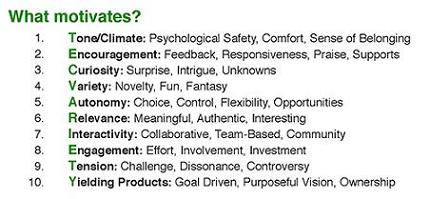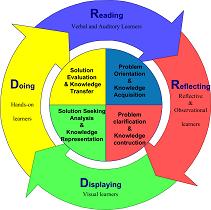ADDING SOME TEC-VARIETY
100+ Activities for Motivating
and Retaining Learners Online
Selected Books by the Same Authors
Purchasing Options:
Paperback: $39.95 978-1-13-880741-9 March 15th 2015 Hardback $165.00 978-1-13-880740-2 March 14th 2015 |
|
Curtis J. Bonk, Mimi M. Lee, Thomas C. Reeves, & Thomas H. Reynolds (2015). MOOCs and Open Education Around the World. Routledge.
As new digital forms of informal and formal learning proliferate, there is an increasing need to better understand how people in different regions of the world are implementing massive open online courses (MOOCs) and other forms of open educational resources (OERs). Educators, researchers, politicians, and countless others want to grasp what the outcomes of these initiatives are and how they can be improved. Current e-learning changes have caused institutions and organizations to grapple with issues of accreditation, credentialing, quality standards, innovative assessment, and learner motivation and attrition, among numerous other areas of concern.
In response, MOOCs and Open Education Around the World explores and illuminates unique implementations of MOOCs and open education across regions and nations. The book also focuses on the various opportunities as well as the dilemmas presented in this age of technology-enabled learning. What are the different delivery formats, interaction possibilities, assessment schemes, and business models? What are the key controversies or issues that need to be discussed and addressed? This edited collection explains MOOCs and open education trends and issues in a variety of locales, shares key research findings, and provides practical suggestions and recommendations for the near future. See http://moocsbook.com/.
|
 Bonk, C. J., & Khoo, Elaine (2014). Adding Some TEC-VARIETY: 100+ Activities for Motivating and Retaining Learners Online. Amazon CreateSpace.
Bonk, C. J., & Khoo, Elaine (2014). Adding Some TEC-VARIETY: 100+ Activities for Motivating and Retaining Learners Online. Amazon CreateSpace.
Everyone is talking about the need to motivate and engage students. This is true in face-to-face classrooms and is even more true in online environments. Many students are unhappy due to bland online content and unimaginative activities. It is too lock-step and mechanized. There is no room for flexibility, choice, and creativity. Many others are bored since the course does not utilize current technologies. They love their iPads, iPhones, and other wireless and mobile technologies and want their instructors to utilize them. Some feel that the instructors have not addressed their preferred learning approaches. They want hands-on activities where they produce something meaningful as well as time to explore the resources they find the Web.
Based on ten theoretically-driven and proven motivational principles, TEC-VARIETY offers 100 practical yet innovative ideas based on decades of author experience teaching in a variety of educational settings.
Simply put, this is the book you need to grow your online teaching repertoire in ways you may or may not have thought of before. The printed version of this book is available for purchase from Amazon CreateSpace and Amazon.com. This book is also freely available as a PDF document to download, share, and use both in total as well as by chapter; see http://tec-variety.com/.
|
Web Searching in the World of e-Books
E-Learning and Blended Learning
|
Availability of Open Source and Free Software
Leveraged Resources and OpenCourseWare
Learning Object Repositories and Portals
|
Learner Participation in Open Information Communities
Electronic Collaboration
Alternate Reality Learning
Real-Time Mobility and Portability
Networks of Personalized Learning
|
|
Bonk, C. J. (2009). The World is Open: How Web Technology is Revolutionizing Education. San Francisco, CA: Jossey-Bass, a Wiley imprint.
If this book could be shortened to its narrowest point, it would exist as a one line proclamation that states, “Technological development and the Internet have opened up learning to the point where anyone can learn anything from anyone else at any time”. To help explain this highly complex situation and its implications for education, both formal and informal, Curtis J. Bonk outlines ten key technology and learning trends. Using a model called "WE-ALL-LEARN," Dr. Bonk shows how technology has transformed educational opportunities for learners as well as of innovators from the worlds of technology and education that reveal the power of opening up the world of learning. The book is filled with inspiring stories of ordinary learners as well as interviews with technology and education leaders that reveal the power of this new way of learning. For more information visit http://worldisopen.com.
|
|
Bonk, C. J., Lee, M. M., & Reynolds, T. H. (Eds.) (2009). A Special Passage through Asia E-Learning. Chesapeake, VA: Association for the Advancement of Computing in Education.
As Internet access increases in Asia and the rest of the world, the use of e-learning has expanded to offer formal as well as informal educational opportunities that were previously not possible to hundreds of millions of learners.As access widens, unique educational modules, courses, and programs are being designed and evaluated throughout the Asia region. This book presents e-learning activities, primarily within higher education, taking place in eight countries from East, Southeast, South, and Western Asia. As is evident, each country has unique issues, challenges, opportunities, and initiatives related to e-learning and the use of technology in education. For more information visit http://www.editlib.org/p/32264.
|
 Bonk, C. J., & Zhang, K. (2008). Empowering Online Learning: 100+ Activities for Reading, Reflecting, Displaying, and Doing. San Francisco, CA: Jossey-Bass.
Bonk, C. J., & Zhang, K. (2008). Empowering Online Learning: 100+ Activities for Reading, Reflecting, Displaying, and Doing. San Francisco, CA: Jossey-Bass.
Empowering Online Learning is an essential resource for anyone designing or facilitating online learning. It introduces an easy, practical model (R2D2: read, reflect, display, and do) that will illustrate to online educators how to deliver content in ways that benefit all types of learners (visual, auditory, observational, and kinesthetic) from a wide variety of backgrounds and skill levels. The book has 25 unique activities for each phase of the R2D2 model as well as summary tables helping you pick and choose what to use whenever you need it. Each activity lists a description, skills addressed, advice, variations, cost, risk, and time index, and much more! Finally, this book is loaded with current information about emerging technologies (e.g., simulations, podcasts, wikis, blogs) and the Web 2.0. Anyone wanting an update on technology integration in education will want this book. A useful model, more than 100 online activities, the latest information on emerging technologies, hundreds of quickly accessible Web resources, and relevance to all types and ages of learners - Empowering Online Learning is a book whose time has come. Pedagogy is forever linked to technology. For more information visit http://www.trainingshare.com/courseWeb/book.php.
|
|
Bonk, C. J. & Graham, C. R. (Eds.) (2006). Handbook of blended learning: Global perspectives, local designs. San Francisco, CA: Pfeiffer Publishing.
This comprehensive resource highlights the most recent practices and trends in blended learning from a global perspective and provides targeted information for specific blended learning situations. You'll find examples of learning options that combine face-to-face instruction with online learning in the workplace, more formal academic settings, and the military. Across these environments, the book focuses on real-world practices and includes contributors from a broad range of fields including trainers, consultants, professors, university presidents, distance-learning center directors, learning strategists and evangelists, general managers of learning, CEOs, chancellors, deans, and directors of global talent and organizational development. This diversity and breadth will help you understand the wide range of possibilities available when designing blended learning environments. The Handbook of Blended Learning is the first book to provide a forum for issues surrounding the design and implementation of blended learning environments. The book explores the successes and failures, the models and research, the latest ideas and examples that are impacting the design of blended learning environments. The expert panel of contributors will increase awareness of trends and critical issues that readers must consider before launching a blended learning project. For more information visit http://www.wiley.com/WileyCDA/WileyTitle/productCd-0787977586.html.
|
|
Snowman, J., & Biehler, R. F. with Bonk, C. J. Technology Contributor (2000). Psychology Applied to Teaching (9th Edition). Boston, MA; Houghton Mifflin.
Psychology Applied to Teaching makes sense of educational psychology by demonstrating how complex psychological theories apply to the everyday experiences of in-service teachers. More than one-third of the text is devoted to Suggestions for Teaching in Your Classroom, which provide concrete examples of how teachers can use psychological research in real-world teaching situations. Long recognized as the most practical book in its field, this text provides valuable instructional techniques for student and beginning teachers. For more information visit http://www.amazon.com/dp/0395960657/.
|
|
Bonk, C. J., & King, K. S. (Eds.). (1998). Electronic collaborators: Learner-centered technologies for literacy, apprenticeship, and discourse. Mahwah, NJ: Erlbaum.
Two developments in recent years have converged to dramatically alter most conceptions of the teaching and learning process. First, technology has become increasingly interactive and distributed, such that individual learners have available the means to participate in incredibly complex networks of information, resources, and instruction. Second, the conventional teacher-centered model wherein knowledge is transmitted from the teacher to the learner is being replaced by social constructivist and learner-centered models of instruction.
As a consequence of these developments, teachers need guidelines from educational researchers about integrating collaboration and communication tools into their classrooms. This volume presents research on such collaborative technology as it facilitates, augments, and redefines academic learning environments. The studies illustrate how schools, teachers, and students are discovering, employing, and modifying the numerous new computer conferencing and collaborating writing tasks and tools, and their effects on social interaction and resulting student learning. Documentation is given that will help teachers to make decisions that productively transform learning environments.
This is a must-read volume for all researchers, scholars, graduate students, and practitioners interested in such fields as sociocultural theory, process writing, cooperative learning, learner-centeredness, distance education, peer conferencing and tutoring, mentoring, electronic collaboration, problem- and project-based learning, collaborative writing, and educational reform.
For more information visit http://www.amazon.com/dp/0805827978/.
|
MOOC Book
MOOCs and Open Education Around the World
|